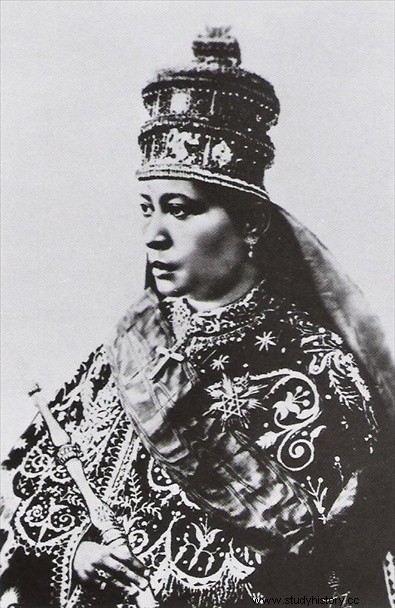Zewditou (1876 – 1930) was a ruler of Ethiopia at the beginning of the 20th century, whose reign was marked by great changes for the country.
Very early marriages
 Born on April 29, 1876, Zewditou is the daughter of the noble Abechi, companion of Sahle Maryam who later became Negus (king) of Ethiopia as Menelik II. The child is baptized "Askala Maryam", after a flower name; but it is called Zewditou. Motherless at a young age, Zewditou was raised by her father and his new wife Baffana, alongside two other recognized children:Asfaw Wossen and Shewaregga, who would be the mother of Menelik's heir.
Born on April 29, 1876, Zewditou is the daughter of the noble Abechi, companion of Sahle Maryam who later became Negus (king) of Ethiopia as Menelik II. The child is baptized "Askala Maryam", after a flower name; but it is called Zewditou. Motherless at a young age, Zewditou was raised by her father and his new wife Baffana, alongside two other recognized children:Asfaw Wossen and Shewaregga, who would be the mother of Menelik's heir.
Barely six years old, Zewditou is engaged to the son of the Negus Yohannes IV, Araya Selassie Yohannes, a political union aimed at getting Menelik to recognize the authority of his rival Yohannes. The couple married in 1886 when the girl was only ten years old. They will have no children, Araya dying in 1888 and Zewditou returning to his father. Despite her young age, it seems that she tried hard to maintain good relations between her father and her father-in-law, the two rival rulers.
Subsequently, two other marriages are contracted for her but do not last. Zewditou ended up marrying Gougsa Wellé, a high-ranking soldier and nephew of his father's new wife Taytu Betul. Unlike the previous ones, the union will be long-term and seems to have been harmonious.
Zewditou in power
On the death of Yohannes, Menelik is supported by the Ethiopian nobility and obtains the imperial throne. Having no male heir, he designates to succeed him Iyasu, the son of Shewaregga with whom Zewditou grew up. A woman of power and character, Taytu Betul plots to make Zewditou her husband's heiress, but fails. When Menelik died in 1913, Iyasu became the new Negus Negest, the Emperor of Ethiopia.
Striving to politically integrate the country's Muslim minorities, Iyasu has drawn the wrath of the Christian elites as he has drawn those of the European powers by approaching the Triple Alliance during the Second World War. On September 27, 1916, the emperor was overthrown by a coup d'etat and Zewditou was chosen to replace him; his stepmother Taytu Betul, recalled to the palace on occasion, may have played a role in this takeover. Zewditou was crowned in February 1917.
The Reign of Zewditou
Assisted by the prince-regent (and heir to the throne) Täfäri Makonnen, future Hailé Selassie, Zewditou mainly deals with formal matters. Marked by the guilt of having taken the throne from Iyasu, held captive, she pleads in his favor and ensures that his living conditions are decent. As the years pass, the gap widens between the Negiste Negest and the heir to the throne. Supporter of the modernization of the country, while Zewditou is more conservative and particularly attached to traditions as well as to religion, Täfäri Makonnen gradually increases his power and influence. In 1928, the Empress was forced to grant him the title of Negus. Several uprisings against Täfäri Makonnen fail. In 1930, it was Gougsa Wellé, Zewditou's husband, who tried to raise a rebellion against him, but he failed and was killed at the Battle of Anchem in March 1930.
On April 2, 1930, barely two days after the death of her husband, Zewditou also died. Some popular stories maintain that the shock of Gougsa Wellé's death would have killed her; others that she had not yet been informed of the outcome of the battle; others, finally, that she was poisoned. She may also have died of diabetes or typhoid. The day after his death, Täfäri Makonne was proclaimed negusse negest of Ethiopia, as Haile Selassie I st .
Zewditou rests in a mausoleum in the Menelik Palace, alongside his father and stepmother Taytu Betul.
